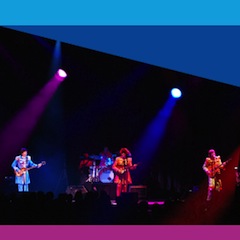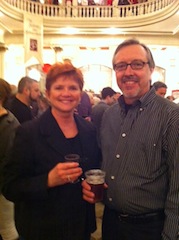
"Classical Mystery Tour" Enjoyable Trip for Pops
Fifty years ago The Beatles hit the American
shores and changed the landscape of the music industry, creating a new era in
rock and first appearing on The Ed Sullivan Show (watched by 40% of the
American public) on February 9, 1964.

From that point forward, rock ‘n roll history
was changed. The U.S. was still mourning the loss of
President John F. Kennedy. It was a time of change and uncertainty in America,
with the Civil Rights Movement, the escalating conflict in Vietnam, and the
Cold War. An entire generation of Americans was hungry for something new -- a
pop culture diversion -- and The Beatles perfectly fit that mold. In the next
five years, The Beatles had 21 number one singles and are still the best
selling band in U.S. history. Although pop music
concentrates on American traditions and the Beatles were British, the group’s
influence can be seen throughout American pop culture and music-making.
Playing to a sold out house in Music Hall Feb.
9, The Cincinnati Pops Orchestra presented “A Classical Mystery Tour,”
featuring a Beatles tribute band. Jim Owen as John Lennon, Tony Kishman as Paul
McCartney, John Brosnan as George Harrison and Chris Camilleri as Ringo Starr performed
an array of Beatles’ songs, ranging from “I Saw Her Standing There” to “Eleanor
Rigby.”
According to local music expert Stan Hertzman, “The Beatles’ impact was not only musical, but also social, political, economic and, arguably, religious. It was the perfect storm for this band at that time to have a lasting effect, starting the whole British invasion of bands including the Rolling Stones, The Who, The Animals, The Kinks, The Hollies and The Yardbirds, who were instrumental in shaping the music of our times.”
While the group, all Americans, spoke with a British accent, looked like The Beatles, sang many Beatles’ hits and dressed in black and white and psychedelic costumes, their intonation was sometimes off. “Sgt. Pepper’s Lonely Hearts Club Band” was enthusiastic, but not quite The Beatles’ sound. Conducted by Robert Trevino, The Pops successfully backed up arrangements of such songs as “I am the Walrus,” “Lady Madonna,” “All You Need is Love,” “The Long and Winding Road,” “A Hard Day’s Night” and the famous “She Loves You.” One highlight was “Good Night,” sung by Camilleri as Ringo Starr. Many baby boomers enjoyed the concert, joining in with applause and sing-a-longs. An ever-changing, colorful background with multi-media effects rotated according to the character of the songs.
Conducted by the Cincinnati Symphony Orchestra’s associate conductor Robert Trevino, the Fab Four played 30 timeless classics Sunday, and performed exactly as they were recorded, complete with original orchestrations.
One audience member, Ray (he would not give
his last name) said, “It’s very difficult to do an imitation.” He thought the
band was a little harsh and lacked a certain mellowness. On the other hand, Kathie and Gary Schmidt drove from Lawrenceburg, Indiana to hear the concert. Gary
said, “I’m enjoying it a lot. It’s
fun stuff.” His reaction was
echoed by Jose and Deb Guerra of Milford, who both found the Beatles concert enjoyable.

WSAI-AM was the first Cincinnati radio station to play The Beatles, just a month before their appearance on The Ed Sullivan Show. By August 27, 1964, the group had accepted an offer to play at the Cincinnati Gardens. CBS celebrated the 50th anniversary of their Ed Sullivan debut with “The Night That Changed America: A Grammy Salute to the Beatles” on February 9, 2014.
A recent CBS News story encapsulates the influence and excitement of The Beatles, with testimonials from musicians inspired to pursue the craft of music after hearing them on the Ed Sullivan Show that night. Here's the link: http://www.cbsnews.com/news/the-beatles-when-a-new-generation-of-musicians-discovered-themselves/